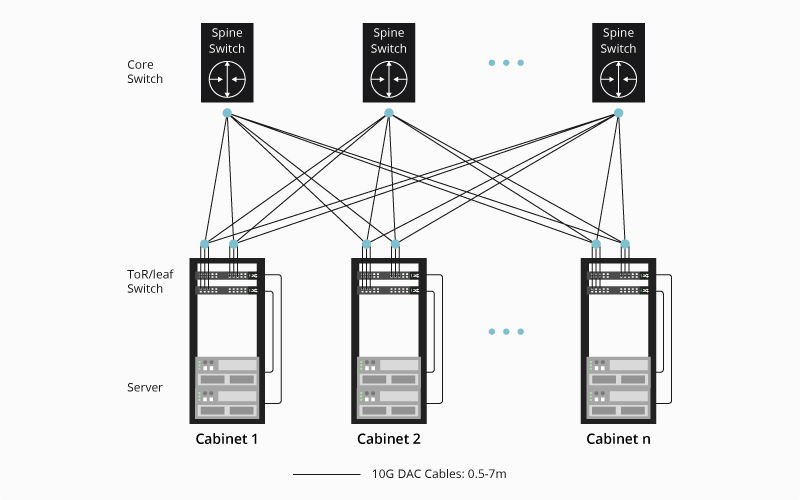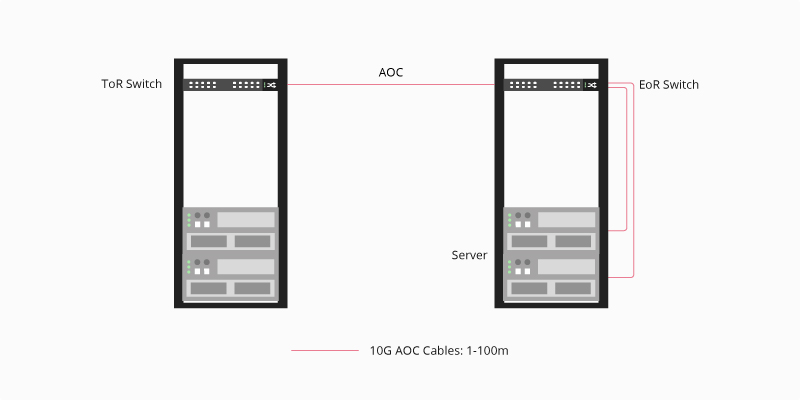

 Knowledge Base +
Knowledge Base +  2023.12.07
2023.12.07With the advantages of lower cost and easier installation, SFP+ cables are getting more and more popular for short-distance connectivity in 10G data transmission than 10G transceivers. This article offers a buying guide for 10G SFP+ cables from the aspects of types, benefits, applications and choosing tips.
10G SFP+ Cable: Definition and Types
SFP+ cable is a form of high-speed cable with SFP+ connector modules on either end. It uses the connector to transmit and receive 10Gbps data through one paired transmitters and receivers over a thin twinax cable or a fiber optic cable. They are suitable for in-rack connections between servers and switches, saving significant costs and power in short-reach applications. 10G SFP+ cables can be classified into 10G SFP+ DAC and 10G SFP+ AOC.
10G SFP+ DAC Cable
10G DAC, classified into passive DAC and active DAC, is made from twinax copper and is factory terminated with modules that provide an electrical connection directly into active equipment. The former can deliver without signal conditioning, while the latter has electric components inside the transceivers to boost signals. 10G SFP+ DAC cable is ideal for shorter top-of-rack or rack-to-rack runs with cost-conscious budgets.
10G SFP+ AOC Cable
10G AOC is an amalgamation of optical components and electronics or active electrical components, requiring external power to complete the conversion of signals. It uses a fiber cable and silicon chip and provides an electrical-to-optical connection to boost the signal and performance of the cable. 10G SFP+ AOC cable is generally used for end-of-row or middle-of-row data center architectures for interconnecting distances of up to 15m.

Figure 1: 10G SFP+ Cables
Benefits of SFP+ Cable
Cost: Without expensive electronic components, 10G SFP+ cable is much cheaper than 10G optical transceivers. And with a power consumption of lower than 0.15w, the operating expenses of passive DAC will be much fewer.
Convenience: It is more flexible and less difficult to adopt 10G SFP+ cables during the actual construction deployment. Just plug SFP+ cables into your physical equipment (such as network switch) directly, the connection is achieved without any additional signal processing or conversion.
Applications of SFP+ Cable
10G SFP+ DAC and AOC are widely adopted in data centers to connect servers, storage appliances and switches. In general, these cables are particularly effective in the following two applications.
10G SFP+ DAC Cable: Server to Switch Connectivity
10G SFP+ DAC is usually applied for ToR (Top of Rack) interconnections between 10G ToR switch and server or the stacking of 10GbE switches. Since 10G SFP+DAC typically supports a link length of 7m with low power consumption, low latency and low cost, this option is an ideal choice for short-range server-to-switch connections.

Figure 2: 10G SFP+ DAC Cable: Server to Switch Connectivity
10G SFP+ AOC Cable: Switch to Switch Connectivity
Without the strict link length limits, 10G SFP+ AOC is commonly used in several locations in the data center like ToR, EoR (End of Row) and MoR (Middle of Row). Therefore, 10G SFP+ AOC cable assemblies are high-performance and cost-effective I/O solutions for 10G Ethernet and 10G Fibre Channel applications. With the theoretical maximum reach up to 100m, 10G SFP+ AOC cables are often used in switch-to-switch connections.
 Figure 3: 10G SFP+ AOC Cable: Switch to Switch Connectivity
Figure 3: 10G SFP+ AOC Cable: Switch to Switch Connectivity
What is SFP Connector?
SFP connector or SFP plug is another name of SFP as SFP (small form-factor pluggable) is a compact and hot-pluggable interface connector. The SFP connector module functions as the intercommunication media between the network devices and cables to achieve photoelectric and electro-to-optical conversion. SFP interface is commonly used in SFP port network equipment such as Ethernet switches, firewalls, routers, network interface cards (NICs) for both data communication and telecommunication applications.

Figure: the optical interface of the 1000BASE-SX SFP connector module is located at the side of the dust cap. Once unplug the cap, will you see the optical interface.
According to transmission media, there are SFP copper connectors and SFP fiber connectors. Copper SFP uses an RJ45 SFP connector interface, whereas fiber SFP uses SFP lc connector, SFP sc connector, and SFP MTP/MPO connector interface as typical ones. According to the SFP forms, different SFP form factors often utilize corresponding SFP connectors.
The table below shows the SFP connector interface types for different SFP types.
| SFP Types | Media | Connector |
|---|---|---|
| 100 Mbit/s SFP | Fiber,copper | LC, RJ45 |
| 1 Gbit/s SFP | Fiber, copper | LC/SC, RJ45 |
| 1 Gbit/s cSFP | Fiber | LC |
| 10 Gbit/s SFP+ | Fiber, copper, DAC | LC, RJ45 |
| 25 Gbit/s SFP28 | Fiber, DAC | LC |
| 50 Gbit/s SFP56 | Fiber, DAC | LC |
| 4 Gbit/s QSFP | ||
| 40 Gbit/s QSFP+ | Fiber, DAC | LC, MTP/MPO |
| 50 Gbit/s QSFP28 | Fiber, DAC | LC |
| 100 Gbit/s QSFP28 | Fiber, DAC | LC, MTP/MPO-12 |
| 200 Gbit/s QSFP56 | Fiber, DAC | LC, MTP/MPO-12 |
| 400 Gbit/s QSFP-DD | Fiber, DAC | LC, MTP/MPO-16 |
What Type of Connector is Used with an SFP Port?
SFP ports are frequently found in Ethernet network switches. These switches with 1G SFP ports as the major functional switch ports are called gigabit SFP switches.
SFP port on SFP switch supports both SFP copper connector and SFP fiber connector while RJ45 port can only take copper SFP module RJ45 connector. SFP connector types that 1G SFP port can take are RJ45 SFP connector, SFP lc connector, SFP sc connector.
FAQs about SFP Transceiver
Can We Use SFP Hardware in SFP+ Slots?
In many cases, the SFP+ port accepts SFP optics, but the speed will be down to 1G instead of 10G. However, SFP+ optics can not be plugged into the SFP port, because SFP+ does not support speed under 1G. In addition, almost all SFP+ ports on Cisco switches can support SFPs, but many SFP+ ports of Brocade switch only support SFP+ optics.
Can I use a 1000base-LX sfp for 1000base-SX fiber?
Generally, they are not interchangeable. 1000Base SX and LX are two optics standards with different operation wavelengths.1000Base LX SFP transceiver usually operates at 1310nm and uses single-mode fiber to connect, while 1000Base-SX usually is 850nm SFP and works with multimode fiber.
Can you aggregate multiple SFP ports?
Of course, you can. Link aggregation provides benefits like increased bandwidth, redundancy, and load-balancing. That will ensure that one link can immediately switch to a second available link when it fails. Therefore, aggregation on SFP ports is critical for enterprise networks where performance and security are more important. But note that, before connecting the SFP ports, please make sure that the switches have been configured for link aggregation. Otherwise, it will cause network loops.
Subscribe to the newsletter
for all the latest updates.
2-5# Building, Tongfuyu Industrial Zone, Aiqun Road, Shiyan Street, Baoan District, Shenzhen. China
